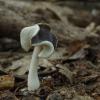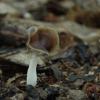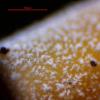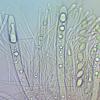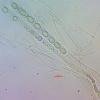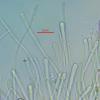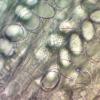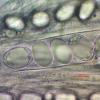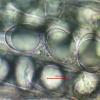
12-11-2025 09:25
 Viktorie Halasu
Viktorie Halasu
Hello, I need help with a pale terrestric Pseudom

11-11-2025 20:16
Bohan JiaHi, lastly I have found these tiny yellow decayin

09-11-2025 13:20
Hello.A tiny ascomycete, appearing as erupting gra

08-11-2025 00:29
 Francois Guay
Francois Guay
I found this species in Quebec, Canada, on herbace
Helvella bicolor (syn. ?H. albella) ????
Marek Capoun,
20-03-2022 21:20
 Hello everybody, can you help me with the confirmation of this small Helvella?
Hello everybody, can you help me with the confirmation of this small Helvella?It was collected in September, on rich humous or loess soil under Acer, Tilia and Fraxinus.
Cap saddle-shaped or rather regularly trilobate, to 10 mm on average, the margin rolled upwards (deflexed), hymenium dark brown, lighter after getting wet, outer surface white or whitish, strongly contrasting with hymenium; stipe max. 20 mm long, 2–5 mm wide, tapering upwards; outer side and stipe pubescent - fine, but visible to the naked eye, drying furfuraceous (rather than pubescent). Microscopy with the drying material in water. Asci 300–350 x 16–20 µm, paraphyses enlarged to 5-9 µm on the top. Ascospores (15.7) 18.9–21.1 (22.3) × (11.5) 12.5–14.1 (14.6) µm; Q = (1.1) 1.4–1.55 (1.6) ; N = 44; but the maturity is questionable.
The problem is with the receptacle or stipe surface. If I respect my specimen, i.e. pubescent surface, the keys lead me into a dead end. And the glabrous surface leads me to H. levis Bergeret (=H. latispora Boud.?) or H. bicolor Raddi (= H. albella Quél.) in the key by Skrede et al. This key is fully consistent with Bergeret's original description of H. levis (i.a.) (in French): "Helvelle lisse ... Chapeau très-lisse en dessous ... Colonne très-lisse; très-blanche..." etc. This same for H. latispora - Boudier writes (in Latin): "... parte inferà et pediculo albidis, laevibus ... Pediculus glaber ..." etc.
Then I don't understand Nicolas's opinion on those topics:
http://www.ascofrance.com/search_forum/70277
http://www.ascofrance.com/search_forum/63851
However, this problem is eliminated with Helvella bicolor (H. albella). Raddi in his original description doesn't talk about the surface of the receptaculum or of the stem, but Quélet writes (in French): "... subcartilagineuxet peridium membraneux, ..., finement floconneux et d'un blanc de neige..."
So I'm confused.
Thanks for your help.
Marek
Nicolas VAN VOOREN,
21-03-2022 14:48

Re : Helvella bicolor (syn. ?H. albella) ????
Dear Marek,
I think your collection may be H. latispora, a species which is not really glabrous based on my type revision. This is why I disagree with the use of H. levis as a priority synonym (Skrede et al., 2017).
But of course you can have a different opinion.
I think your collection may be H. latispora, a species which is not really glabrous based on my type revision. This is why I disagree with the use of H. levis as a priority synonym (Skrede et al., 2017).
But of course you can have a different opinion.
Marek Capoun,
21-03-2022 18:32

Re : Helvella bicolor (syn. ?H. albella) ????
Dear Nicolas, well, opinions can be different, but either something is true or it is not :-)
So two more questions (and thanks for your patience):
Why do the described characters not be appropriate for H. albella?
Is your type revision of H. latispora published somewhere?
Thanks a lot.
So two more questions (and thanks for your patience):
Why do the described characters not be appropriate for H. albella?
Is your type revision of H. latispora published somewhere?
Thanks a lot.
Mario Filippa,
22-03-2022 01:47
Re : Helvella bicolor (syn. ?H. albella) ????
However I have never seen a single specimen with a really naked stipe, in this section (only the sulcate species can be completely naked).
Most of the older description do not take in account the very fine pubescence of the stipe. And some of them are most "smooth" versus "sulcate" than pubescent vs. naked.
Ciao
Mario
Marek Capoun,
23-03-2022 11:26

Re : Helvella bicolor (syn. ?H. albella) ????
O.k., thanks, Mario. It never occurred to me that a smooth surface did not equal without pubescence, but equal unribbed.
Nicolas VAN VOOREN,
24-03-2022 09:48

Re : Helvella bicolor (syn. ?H. albella) ????
Marek,
About the revision of Helvella latispora type, data can be found in the following paper (available on ResearchGate) :
Van Vooren N. 2010. Notes sur le genre Helvella L. (Ascomycota, Pezizales). 1. Le sous-genre Elasticae. Bulletin mycologique et botanique Dauphiné-Savoie, 199: 27-60.
About H. bicolor (syn. H. albella), this species is morphologically closer to H. elastica
Finally, about the pubescence: of course, in a modern sense, smooth/naked is different from "non sulcate", but Mario is right when he explains what the ancient authors suggested with these terms.
About the revision of Helvella latispora type, data can be found in the following paper (available on ResearchGate) :
Van Vooren N. 2010. Notes sur le genre Helvella L. (Ascomycota, Pezizales). 1. Le sous-genre Elasticae. Bulletin mycologique et botanique Dauphiné-Savoie, 199: 27-60.
About H. bicolor (syn. H. albella), this species is morphologically closer to H. elastica
Finally, about the pubescence: of course, in a modern sense, smooth/naked is different from "non sulcate", but Mario is right when he explains what the ancient authors suggested with these terms.
Marek Capoun,
24-03-2022 13:11

Re : Helvella bicolor (syn. ?H. albella) ????
Thanks, Nicolas, I really appreciate your help.
M.
M.

